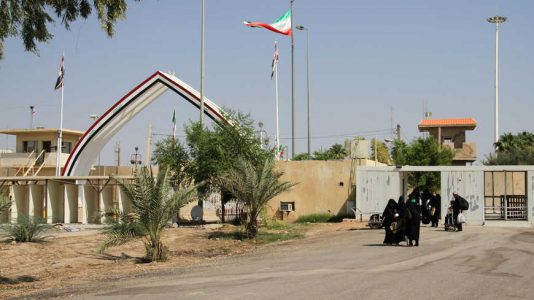
Islamic State terrorists conduct attacks near Iraq’s Syrian and Iranian borders
An uptick in Islamic State (IS) attacks in Iraq’s Diyala province, which borders Iran but also stretches south to the outskirts of the capital, has concerned Iraqi officials and analysts.
On April 27, Iraqi Army Chief of Staff Lt. Gen. Othman Al-Ghanmi visited the 5th Division in Diyala to assess the current situation in light of the increased threat. There have also been significant security incidents in recent weeks in neighboring Kirkuk and Salahuddin provinces, including an attempted suicide attack on Kirkuk intelligence offices on April 28.
A screen grab from an IS video showcasing fighters launching mortars under a bright Iraqi sun “shows they are confident enough now to conduct attacks in the daytime,” a Diyala security officer told Al-Monitor in an interview conducted via WhatsApp on April 25.
“The attacks always used to happen only after it got dark,” he added, noting that the screen grab sent to Al-Monitor was of an attack conducted about two weeks before near Lake Hamreen in Diyala.
The Diyala security officer, who cannot be named as he had not received authorization to speak to the media, said that “IS uses groves of trees between Kulajo to Jalawla to hide in.”
He claimed that among the IS fighters active in the area are Kurdish Iranians who have crossed into the province from Iran as well as dozens of locals from the Karwi tribe in Jalawla.
When this journalist reported from Jalawla in April 2015, over four months after it was retaken from IS, one peshmerga forces officer claimed the tribe had “accounted for slightly more than half the inhabitants prior to IS’ entrance, but that the land had been entirely Kurdish prior to its forced Arabization.”
On April 3, peshmerga forces announced the arrest of a local IS leader in Diyala who had taken part in several attacks on their forces in Jalawla and Qaratapa when the towns were still under the control of the Kurdistan Regional Government (KRG), starting in 2014 — a 68-year-old man captured by the Asayish in Kalar on March 16 later confessed.
The province has seen the largest number of IS attacks in the country for months. In March, for example, Diyala suffered the most violence with 26 recorded incidents.
Washington Institute for Near East Policy fellow Michael Knights wrote in an April 24 tweet that “Diyala is the top-ranked attack locale for [IS]. Assuming that these nine IED attacks are enemy-initiated and not legacy IEDs or criminal, that would be about twice the rate seen in H2 2019 and Q1 2020” on the incidents listed in an Iraq Security and Humanitarian Monitor report issued by the Enabling Peace in Iraq Center (EPIC)
In a 2013 CTC Sentinel report, Knights and Iraq security analyst Alex Mello noted that since 2003 Diyala had “served as a fallback location for the takfiri predecessors of the Islamic State.”
This journalist reported from the frontline with peshmerga forces during the fight to retake Jalawla from IS in 2014. The international terrorist organization had taken the town in August, lost it briefly and then retook it again, according to officers who spoke to Al-Monitor at that time. Peshmerga forces won it back in late November 2014.
The commanding officer this Al-Monitor reporter accompanied during her time on the Jalawla frontline and at a peshmerga base in Khanaqin in 2014 was Gen. Hussein Mansour, a Shiite Feyli Kurd who was killed by an IS sniper some months later near Kirkuk.
Iraq’s central government forces took Kirkuk and Jalawla away from the peshmerga in October 2017.
Tensions between the KRG and the central government in Baghdad over territory, oil revenue and other issues also continue to result in security gaps and a lack of coordination susceptible to exploitation by insurgent groups.
The Diyala security officer noted that various Iran-backed Popular Mobilization Units (PMU) had abandoned some of their positions in the province in March, allegedly due to concerns about being targeted by US drone strikes, and that weaponry left behind had then been taken by IS fighters.
He claimed that the mortars and ammunition shown in the footage had previously almost certainly been in the hands of Iran-backed PMU.
Armament Research Services director Nic Jenzen Jones told Al-Monitor that the screen grabs of IS fighters shooting mortars in Diyala showed ”Iranian M91 81 mm high-explosive mortar projectiles, fitted with AZ111A-series fuze,” and that ”there have been quite a few with Iranian-supported Iraqi Shiite militias,” but that it was rare to see them in IS hands.
In response to emailed questions, coalition spokesman Col. Myles B. Caggins III said April 26 that Combined Joint Task Force – Operation Inherent Resolve had conducted only two airstrikes this year in the Diyala region, both “at the request of the Iraqi Security Forces.”
Reports of greater activity by IS in this period, he said, had been partially “due to the Iraqi Security Forces’ direct action against [IS] hideouts in the mountainous regions and rural areas in north-central Iraq,” implying that the rash of attacks was more defensive on the part of IS than offensive.
Caggins confidently claimed that a large number of security forces — namely the federal police, the counterterrorism service, the army, the peshmerga and the international coalition — were “thumping [IS] wherever they pop up.”
On April 25, Britain announced it had conducted its first anti-IS airstrikes in seven months on April 10. The target was near Tuz Khurmato in Kirkuk province.
In addition to a number of other IS incidents in the Salahuddin and Kirkuk regions in recent weeks, attacks have also occurred along Iraq’s border with Syria.
Reports indicate that IS killed a member of al-Waleed district council and kidnapped his son on April 26. The Iraqi security media cell said that the official, Sheikh Talal al-Amsi, had been killed and his brother and wife injured in the attack in the border area of western Anbar.
Source: Al Monitor





